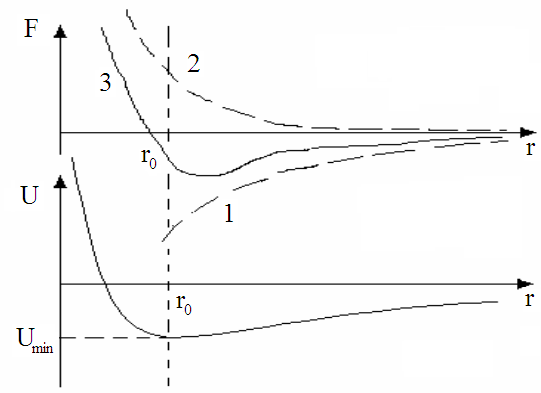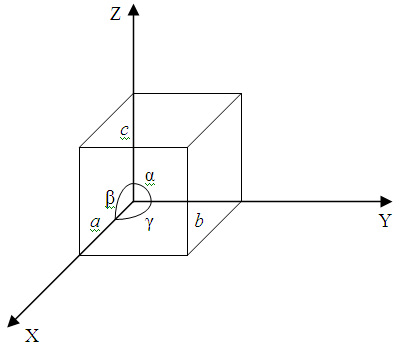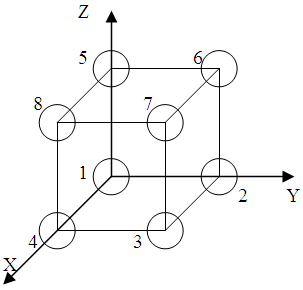
- •Методичні вказівки
- •1. Лабораторна робота № 80 Елементи структури кристалічних тіл
- •1.1 Теорія
- •1.2 Завдання
- •Контрольні запитання
- •Література
- •3. Лабораторна робота № 81 елементи фізичної статистики
- •3.1 Теорія
- •3.2 Завдання 1
- •3.3 Завдання 2
- •Контрольні запитання
- •Література
- •5. Лабораторна робота № 82.1 вивчення електропровідності напівпровідників
- •5.1 Теорія
- •5.2 Експериментальна частина
- •5.3 Завдання 1
- •5.4 Завдання 2
- •Контрольні запитання
- •Література
- •Інструкцію склав доцент каф. Фізики знту Корніч в.Г. За допомогою ст. Лаборантів каф. Фізики знту Суровцева о.К. Та Косирєва о.О.
- •6. Лабораторна робота № 82.2 вивчення електропровідності металів
- •6.1 Теорія
- •6.2 Завдання 1
- •6.3 Завдання 2
- •Контрольні запитання
- •7. Лабораторна робота № 82.3 вивчення електропровідності твердих тіл
- •7.1 Теорія
- •7.2 Завдання 1
- •7.3 Завдання 2
- •Інструкцію склав доцент каф. Фізики знту Корніч в.Г. За допомогою ст. Лаборантів каф. Фізики знту Суровцева о.К. Та Косирєва о.О.
- •8.1 Теорія
- •8.2 Завдання 1
- •8.3 Завдання 2
- •Контрольні запитання
- •Література
- •Інструкцію склав доцент каф. Фізики знту Корніч в.Г. За допомогою ст. Лаборанта каф. Фізики знту Суровцева о.К.
Література
1. Ч. Киттель, Элементарная физика твёрдого тела. – М.: Наука, 1965.
2. Епифанов Г.М. Физика твёрдого тела. – М.: Высшая школа, 1977.
Інструкцію склав доцент каф. фізики ЗНТУ Корніч В.Г.
Рецензент: доцент каф. фізики ЗНТУ Єршов А.В.
2. LABORATORY WORK № 80
Study of the crystal structure
THE AIM: to determine of the crystal lattice parameters.
THE TASK: to determine the indexes of the sites, the directions and the planes, the density packing of atoms, the coordination number and interatomic distance given crystal lattice.
INSTRUMENTATION AND APPLIANCES: models of crystals.
2.1 Introduction
Crystals are formed from atoms, sometimes in simple and sometimes in complicated ways. Many crystals built up of ions bearing positive and negative charges: rock salt is composed of Na+ and Cl- ions. Crystals of the alkali metals are made up of small positive ion cores immersed in a negatively charged sea of conduction electrons. Some crystals are made up of neutral atoms having slightly overlapping electron clouds forming electron bridges or covalent bands between neighboring atoms.
The differences among these varieties of crystal line binding forces are closely connected with differences in the mechanical, electrical and magnetic properties of crystals. In all crystals the actual interaction which causes the binding is almost entirely the ordinary Coulomb electrostatic interaction between charges - the attraction between the negative charges of the electrons and the positive charges of the nuclei. The differences in the types of crystalline binding thus are not differences in the nature of the interaction, but are qualitative differences in the distribution of electronic charge. One of the questions in the physics solid state is "Where are the nuclei and the electrons in the solid?" This problem is called the determination of the structure of the solid.
All atoms are constructed of various elementary particles and a complete descriptions of a solid would simultaneously specify the condition of all these particles. However, such a description is unnecessarily complex for most purposes. An approximation sufficiently accurate for the study of the geometrical arrangement of entire atoms in crystals is to suppose the atoms to be round, hard balls. These balls rest against each other in various geometrical arrangement. Solids have its own mode of atom placement.
The solids of primary interest for us have an arrangement of atoms in which the atoms are arranged on some regular repetitions pattern in three dimensions. Such solids are called crystals, and the arrangement of atoms is termed the crystal structure.
The internal regularity of atom placement in solids often leads to symmetry of their external shapes.
Suppose that are some atoms in the neighborhood of our origin O. The translational invariance insists that there must be exactly similar atoms, placed similarly about each lattice site.
It is obvious that we can define the physical arrangement of the whole crystal if we specify the content of a single unit cell.
The whole crystal is made up of endless repetitions of this object stacked like bricks in a wall. Suppose that there is some central symmetry about some point in the structure. This would be a convenient point to choose as the center of a cell, itself with central symmetry. One can do this systematically by constructing a Wigner-Seitz cell, that is, by drawing the perpendicular bisector planes of the translation vectors from the chosen center to the nearest equivalent lattice sites. The volume inside all the bisector planes is obviously a unit cell - it is the region whose elements lie nearer to the chosen center that to any other lattice site.
The unit cell can contain one or more atoms. Naturally, if it contains only one atom, we put that on the lattice site, and say that we have a Bravais lattice. If there are several atoms per unit cell, then we have a lattice with a basis.
Structures are classified according to their symmetry properties, such as invariance under rotation about an axis, reflection in a plane.
2.2 Crystal lattice
When the atoms draw near, between atoms exist the forces of the interaction. Figure 2.1 shows the dependence of the energy of the interaction and the dependence between them.
It means, that the atoms in crystal lattice must be in equilibrium state, when r near to r.
Then we may to make the conclusion that the atoms must construct in the strict order under influence the forces of the interaction. In result it formed a body with regularity or periodically structure. So bodies are crystals. For describing crystal structure we use the idea of the crystal lattice.

Curve 1: When r > r0 between the atoms there are the forces of the attraction.
Curve 2: When r tends r0 (r => r0 ) between the atoms began to act the repellent forces.
Curve 3: When r = r0, then Fatt = Frep, and so the energy of the interaction reaches
minimum Umin how it shows "b".
Figure 2.1
The crystallization process of a substance occurs due to the forces of attraction acting between its particles. At small his dances disappear and the forces of repulsion appear, preventing the further binding of particles. These forces strive to arrange the particles of substance as closer to each other as possible. In the first approximation we may to compare molecules with solid particles, in particular, with balls of definite radius witch may be brought only into contact by the forces of attraction.
When ball-type particles are packed tightly, each of them is surrounded by a certain number of adjoining (neighboring) particles arranged at equal distances from the first. This number is called a coordination number with values 12, 8, 6, 4 and 2.
The orderly distribution of particles within the volume of a crystal forms co called space crystal lattice. Geometrically the entire pattern of a lattice can be obtained if we draw three systems of planes intersecting between themselves at angles and. The planes in each system are parallel to each other and are spaced at equal distances a, b and c. These planes divide the crystal by unit cells constituting kind of bricks of witch the whole crystal is built. Depending on the ratio between the cell ribs a, b and c as well as the angles we distinguish seven crystallographic systems:
a) a = b = c; α = β = γ = 900 – cubic system;
b) a = b ≠ c; α = β = 900, γ = 1200 – hexagonal system;
c) a = b ≠ c; α = β = γ = 900 – tetragonal system;
d) a ≠ b ≠ c; α = β = γ = 900 – trigonal system;
e) a ≠ b ≠ c; α = β = 900 ≠ γ – monoclinic system;
f) a ≠ b ≠ c; α ≠ β ≠ γ ≠ 900 – triclinic system;
g) a = b = c; α = β = γ ≠ 900 – rhombohedral system.

Figure 2.2
2.3 Mean of sites, directions and plains
Figure 2.3 shows us the simple crystal lattice in the system coordinate X, Y, Z.
The position of the particles define by vector r = ma + nb + pc, where m, n, p is whole numbers; a, b, c is basis vectors of the translation.
In our case |a|=|b|=|c| and it is the lattice constant. If the unit of the length is the lattice constant, then the site coordinates is m, n, p. The index of the sites defined how their coordinate.

Figure 2.3
For example: Site N6 x=0; y=1; z=1, then the index of the site N6 is [[ 011 ]].
We take the length of the parallelepiped edges as a unit.
2.4 The index of the direction
The first way. If we must to define any direction, we must to know coordinates of two points which belong to this direction. For example, we must to determine the direction 5 – 6. Origin of coordinates is the point 1 on fig. 2.2. At first we change this origin on the point number 5 or 6. Let 5 be. Then we will have the new system coordinate X', Y', Z'. In touching system coordinate the direction 5 – 6 cross the origin and then the index of the direction 5 – 6 is the index of the site 6: [[010]]. The mean of the direction 5 – 6 is [010].The second way. In the common case the index of the direction defined by analytical method. For it we use the equation of the straight line
![]() (2.1)
(2.1)
where m1, n1, p1 and m2, n2, p2 are the coordinates of two sites lay in this direction. Then the indexes of this direction are the quantities of the denominators:
5: [[001]] 6: [[011]]
[m2 – m1 n2 – n1 p2 – p1]
5 – 6 : [0 – 0 0 – 1 1 – 1] => [010] or [010].
2.5 The index of the planes. Miller index
The first way. If the plane cuts on the coordinate axis segments x, y, z in the units of the lattice constants, then there is a number S such that
h = S/x ; k = S/y ; l = S/z.
In result we have h, k, l how minimum whole numbers.
The numbers h, k, l are the index of the plane or Miller index of the plane – (h k l).
The second way. In the common case we must to decide 3-th order determinant

m – m1 n – n1 p – p1
m2 – m1 n2 – n1 p2 – p1 = 0 (2.2)
m3 – m1 n3 – n1 p3 – p1
where [[m1 n1 p1]], [[m2 n2 p2]], [[m3 n3 p3]] are coordinates of three point, which belong this plane. When we had decided this determinant in result we have
hm + kn + lp = 0 (2.3)
Thus we have (h k l).
For the cubic system:
a) normal to the plane with index (h k l) lies in the direction [h k l];
b) distance d between neighbor planes with index (h k l) is
![]() ,
(2.4)
,
(2.4)
where a is the length of the cubic edge. The distance between planes with large index is little compare with distance between planes with little index.
The planes with little index have more high atoms density. The density packing of atoms is the quantity of atoms per unit an area.
At first we must to sketching all possible planes with different indexes. For instance
After that we determine the quantity of the atoms belonged to these planes:
a) N = 1 b) N = 2 c) N = 1/2.

Figure 2.4
Then we calculate the area of these planes S and density n
![]() (2.5)
(2.5)
Compare different ni it is possible to find nmax. For description crystal structure we must determine the coordination number. It is the number of the nearest neighbors.
And also the interatomic distance is the shortest distance between two atoms in a crystal.
Control questions
1 .
What is crystal structure?
.
What is crystal structure?
2. What is unit sell?
3. What is coordination number?
4. What is the density packing of atoms?
5. What is interatomic distance?
Literature
1. Ч. Киттель, Элементарная физика твёрдого тела. – М.: Наука, 1965.
2. Епифанов Г.М. Физика твёрдого тела. – М.: Высшая школа, 1977.
3. Gevorkjan R.G., Shepel V.V. A Course of General Physics. – Moscow: Higher School, 1967. – 550 p.
Translator: Loskutov S.V., professor, doctor of physical and mathematical sciences.
Reviewer: Lushchin S.P., the reader, candidate of physical and mathematical sciences.
